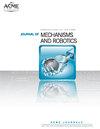Design and Analysis of a 6-DOF Microsurgical Instruments Based on Rigid-flexible Coupling Multi-body System
IF 3.2
4区 计算机科学
Q2 ENGINEERING, MECHANICAL
Journal of Mechanisms and Robotics-Transactions of the Asme
Pub Date : 2023-06-21
DOI:10.1115/1.4062791
引用次数: 0
Abstract
In order to improve the operational accuracy of microsurgical instruments and increase the success rate of surgery, this paper carries out the design and analysis of six-degree-of-freedom (6-DOF) microsurgical instruments based on rigid-flexible coupling multi-body system. Firstly, the kinematic modeling method of the 6-DOF parallel mechanism with flexible hinges is improved based on the pseudo-rigid body theory in this paper. Secondly, a rigid-flexible coupling simulation system is built to analyze the error sources in terms of the remote center of motion (RCM), preload and side load. Then, the function of motion scaling, the accuracy of kinematic modeling and the validity of the workspace are demonstrated by analyzing the workspace. Finally, the maximum stress and modal analysis are solved to ensure the safety and reliability of the application. The analysis results show that the improved kinematic modeling method improves the positioning accuracy by more than two times, the root mean square error (RSME) at the end of the microsurgical instrument does not exceed 10μm in the workspace. And the microsurgical instrument can withstand a side load of 0.1 N at the RCM. This study will provide a reference for the structural design and control algorithm optimization of the 6-DOF parallel microsurgical instruments.基于刚柔耦合多体系统的六自由度显微外科器械设计与分析
为了提高显微外科器械的操作精度,提高手术成功率,本文对基于刚柔耦合多体系统的六自由度显微外科器械进行了设计和分析。首先,基于拟刚体理论,对柔性铰链六自由度并联机构的运动学建模方法进行了改进。其次,建立了刚柔耦合仿真系统,从远程运动中心(RCM)、预载荷和侧向载荷三个方面分析了误差源。然后,通过对工作空间的分析,验证了运动缩放的功能、运动学建模的准确性和工作空间的有效性。最后,对最大应力和模态分析进行了求解,确保了应用的安全性和可靠性。分析结果表明,改进的运动学建模方法将定位精度提高了两倍以上,显微外科器械末端的均方根误差(RSME)在工作空间内不超过10μm。显微外科器械能够承受RCM处0.1N的侧向载荷。本研究将为6自由度并联显微外科器械的结构设计和控制算法优化提供参考。
本文章由计算机程序翻译,如有差异,请以英文原文为准。
求助全文
约1分钟内获得全文
求助全文
来源期刊

Journal of Mechanisms and Robotics-Transactions of the Asme
ENGINEERING, MECHANICAL-ROBOTICS
CiteScore
5.60
自引率
15.40%
发文量
131
审稿时长
4.5 months
期刊介绍:
Fundamental theory, algorithms, design, manufacture, and experimental validation for mechanisms and robots; Theoretical and applied kinematics; Mechanism synthesis and design; Analysis and design of robot manipulators, hands and legs, soft robotics, compliant mechanisms, origami and folded robots, printed robots, and haptic devices; Novel fabrication; Actuation and control techniques for mechanisms and robotics; Bio-inspired approaches to mechanism and robot design; Mechanics and design of micro- and nano-scale devices.
 求助内容:
求助内容: 应助结果提醒方式:
应助结果提醒方式:


